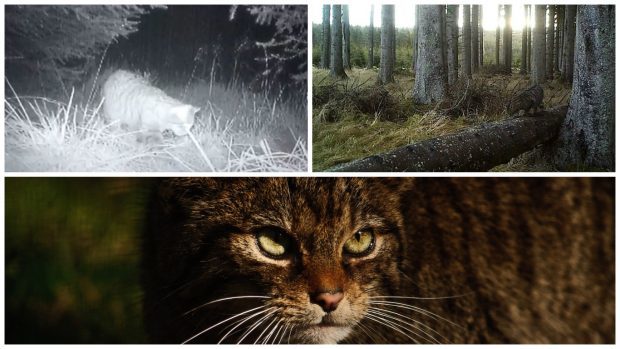A charity hoping to save the Scottish wildcat has claimed a government-backed protection scheme is putting north-east kittens at risk.
Wildcat Haven claims the Scottish Wildcat Action (SWA) project, run through Scottish Natural Heritage, is risking live-trapping of adult female wildcats in Aberdeenshire during breeding season.
The conservation group – which successfully established a safe haven for the animals in Ardnamurchan – is branching out its programme to one of Scotland’s last stronghold of the animals, in Aberdeenshire.
Last month the Press and Journal revealed the group had discovered a sanctum of about 10 of the critically endangered species between Rhynie and Dufftown.
However Wildcat Haven yesterday warned the Aberdeenshire population could be at risk by the SWA’s trap neuter-vaccinate return (TNVR) project, claiming it will run during the March to November breeding season.
The organisation claims animals caught in traps would only be checked every 12 hours, putting offspring depending on the trapped females at risk.
The group’s own “live trapping” scheme runs from November to February in order to reduce any impact on kittens.
Speaking last night the Wildcat Haven’s director, Emily O’Donoghue, said: “We are really concerned by their plans to live trap right in the middle of the wildcat breeding season when there are dependent kittens around.
“Some of the kittens will be starting to wander around, starting to explore and we don’t want them ending up in a trap at this critical time. This is one of the last breeding populations of wildcats.
“The loss of even one wildcat kitten would be a major dent to the remaining population and could threaten its recovery.
“The point to make is there is no way of stopping a wildcat from going into that trap.”
A spokeswoman for SWA confirmed “small scale operations” recently started in Aberdeenshire, but said live trapping was not taking place in areas where wildcats are known to be breeding.
She added: “Wildcat kittens are usually born March-May, (and) are most vulnerable in their first three months and reach independence August to October.
“For this reason, we did not conduct any TNVR activity over the spring and early summer. Our peak TNVR season will be late autumn and winter but the build-up to this begins now.
“We have done extensive work to ensure that wildcats are not accidentally caught during this process of TNVR.
“In the extremely unlikely event that a female wildcat with dependent young ends up in a TNVR trap, it will be released as quickly as possible.”
Both SWA and Wildcat Haven projects aim to neuter and vaccinate feral, non-wildcat felines which are contributing to the iconic species’ decline through interbreeding and disease.
Last night the SWA also responded to Wildcat Haven’s claims that there were “no qualified vets in the field” to oversee its trap-neuter-vaccinate-return (TNVR) operation in Aberdeenshire, unlike its own scheme.
An SWA spokeswoman said the animals must first be trapped in a cage before being taken to a qualified vets to be dealt with before being released.
The SWA spokeswoman added: “All staff and volunteers undergo rigorous training and supervised practical work before they are allowed to conduct TNVR activities and two of our staff members had extensive experience of TNVR prior to joining us.
“This work aims to halt the threat of continuing hybridisation with wildcat and transmission of diseases.
“Because cats that live in the same areas present the greatest risk to Scottish wildcat in terms of interbreeding and disease transmission, we are actively working in and around areas that also contain wildcats.”
Wildcat Haven aims to protect the animals in the wild, and is against conserving the creatures in captivity.
The find in Aberdeenshire last month was described by Mrs O’Donoghue yesterday as a “really important population”.
SWA recently completed the biggest ever wildcat survey in Scotland to inform its trap-neuter-vaccinate-return (TNVR) operation.
